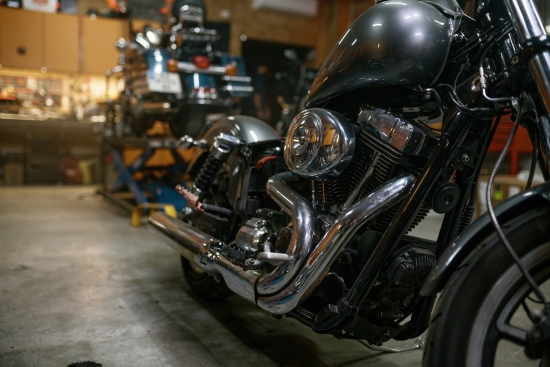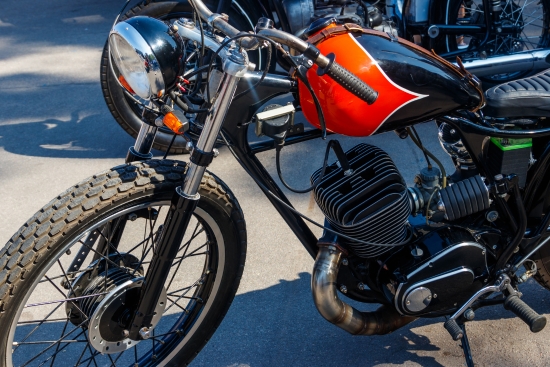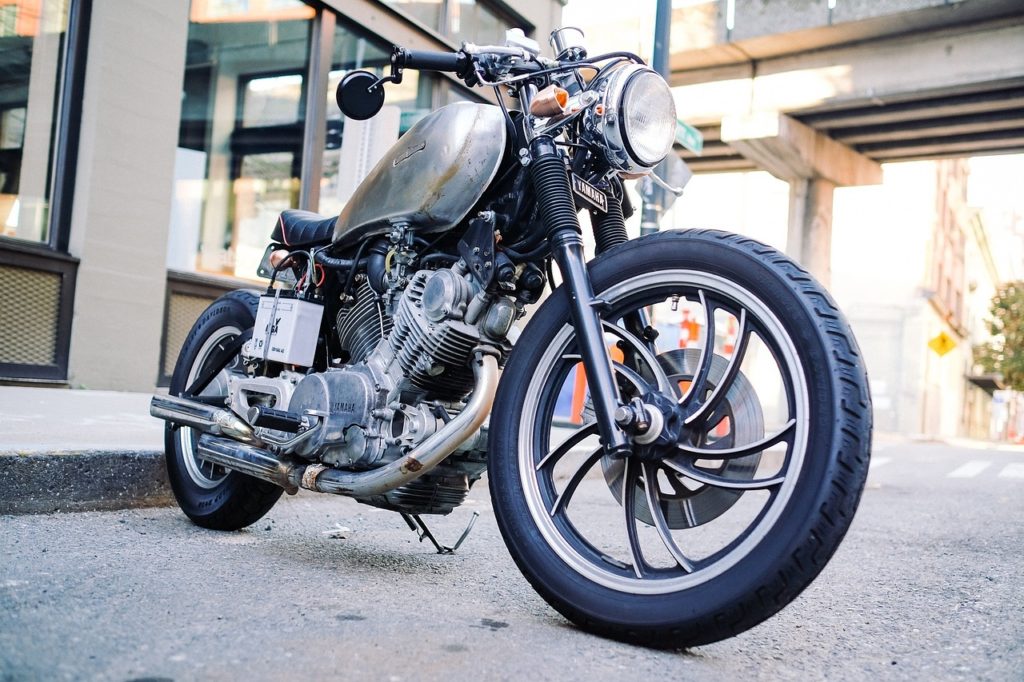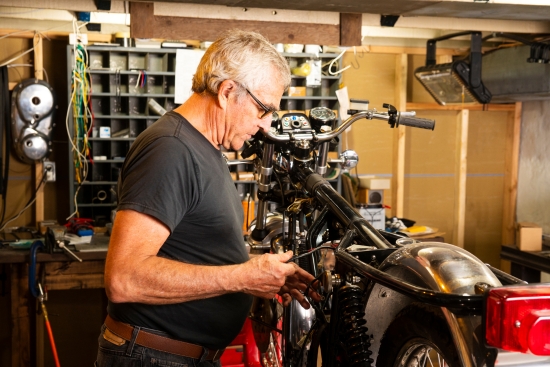Restoring an antique motorcycle takes about 300-350 hours if you have experience. It takes a lot of dedication and you may run into issues where you don’t have the skills, tools, or resources to do part of the work. If you need help with a bike restoration project you can outsource to a shop that will help. Below I will share where to find a good bike restoration shop, what to expect from them, and how to leverage them to stay within budget. I will also share my experience with the motorcycle restoration near me.
Find a Motorcycle Restoration Near Me
If you searching for “Motorcycle Restoration Near Me” or “Who Restores Motorcycles Near Me”, see the map below…
Restoring a classic motorcycle often takes a lot of time, money and skill. Whether it is a salvage bike you picked from a junkyard or a salvage bike you picked up at auction, the time commitment is real. It is estimated by MotorcycleHabit.com that it takes 300-350 hours (about 3 months) to restore a bike in your spare time. That is if you have some experience with restoration.
In my experience for certain tasks, it’s easier to seek out a motorcycle restoration near me to get specialized help. I would rather pay someone to get it right the first time.
How the Motorcycle Restoration Near Me Works
You are not going to go to a local motorcycle mechanic for a motorcycle restoration. Sure they can fix common problems, but you want a shop who specializes in classic motorcycle restoration, which is a different animal. A restoration shop knows how to work vintage bikes, find original parts, and build a restoration to your specs.
These resto shops employ a variety of bike and car experts who specialize in different areas of restoration. You will have different experts on rust removal, part fabrication, finding original parts, paintwork, chrome work, wiring, upholstery, etc…
The motorcycle restoration near me will take a bike from soup to nuts and totally restore it for you. That though is not fun for you and it is really expensive when considering parts and labor. What I recommend is using these shops for very specific tasks that you need help with. Perhaps you don’t have the skills, the tools, or the desire. For example, You can take all your pipes to a shop and have them work the rust and re-dip the chrome.
Why Get Help On Your Motorcycle Restoration Project?…
A long time ago I used to feel that getting restoration help was cheating. Now I see it as a way to do the parts that I enjoy and outsource the parts I don’t do so well. It also has helped me reduce the amount of time it takes to restore the old bike. Now while I have parts that the motorcycle restoration shop is working on, I am at home working on another part of the bike in parallel.
This is particularly a good idea to save up if you don’t have the tools. You can go out and buy the tool, but if you don’t restore many motorcycles, it may not be worth the expense. For the most part, I like to stick to the tasks I enjoy finding original parts, disassembly, rebuilding the engine, and reconstruction.
If you or friends are thinking of outsourcing here are common takes motorcycle restoration shops can help with:
- Repair on the frame (especially if it impacts the structural integrity)
- Removing rust
- Instrument & Gauge Cluster Upgrades (Ask them for their ideas)
- Work on new tire mounts, valve replacements, head gasket replacements, front fork rebuilds, installing electronic ignitions
- Suspension mods and upgrades
- Paintwork
- Electrical work and diagnostics
- Performance upgrades (Custom tuning)
- Leather upholstery work
- Engine rebuilds: including replacing pistons, replacing piston rings, replacing valves.
Trying to do everything on your own is crazy especially if you don’t have the tools and skills. When you need a specialist step back a break from your work and get a pro. You can sometimes do yourself more harm than good, by doing all your own work.
Word of Advice Before You Start an Antique Motorcycle Restoration
If you plan on working on a vintage motorcycle restoration and have never done it before it’s best to call a shop before you start. Find out what they have expertise in and get a price sheet for their services. You may find a shop that does engine rebuilds but doesn’t do any paint work.
These shops are full of motorcycle enthusiasts and have seen it all. In my experience, they will be happy to talk shop and listen to your plan. They often offer a lot of free advice and tips.
When You Call a Shop Be Specific About The Type of Restoration
When you deal with a resto shop, you are putting your project in their hands. You need to communicate what type of resto you are doing. Are you keeping everything original or are you adding some personality?
If you are trying to restore a bike to what it looked like when it rolled off the production line, be specific about that. An original restoration will be more valuable and get the most cash if your plan is to sell it.
On the other hand, you may want to put a little personality and style into the vehicle restoration. Upgrading with mods for instruments, engine mods, and even custom paint work. If you are okay with the shop taking liberties on your behalf make sure to let them know upfront.
Pain Points You May Want to Outsource…
While I don’t recommend outsourcing all of this work, these are just pain points to consider.
Paint and Metal Work
For custom paint or metal integrity work and machine part fabrication, you may want to consider a professional shop.
For paint work one of the best things is you can really get what you want from a custom paint job. Most resto shops can draw or create just about anything to transform your aesthetic vision on the bike. Some even use digital software to help you say what the bike will look like once complete.
Metal work is another great thing to outsource. Minor rust isn’t too difficult to deal with on your own, but for anything beyond small spots, it can be tedious. Ideally, you are working on a resto with not to much rust, but sometimes you don’t have a choice. In the worst case scenario, they may be able to fabricate you a new part.
These folks are also expert welders and are a good place to start if you need a professional weld on wheels or a frame.
Locating Original Parts
The longer a bike has been sitting unused, the more likely that parts have deteriorated and seized. This means you have to find part replacements. For newer bikes that you may be restoring parts are easier to come by. For a classic antique motorcycle parts are much harder to find. You may be able to find some online, but much of this becomes junkyard work.
The motorcycle restoration near me not only uses the internet and junkyards to find parts but leverages a huge network of other restoration companies to find replacement pieces. These folks no all the forums and where to go, especially when trying to keep a motorcycle 100% original.
Wiring and Electric Work
Wiring in a bike is not to complicated depending on the technology you have and the year of purchase the bike. If you have limited experience, you may want to consider outsourcing the wiring and electricity.
If the restoration bike you have purchased has been outside in a salvage yard your wires have been exposed to moisture and may be chewed through by rodents. A bike restoration will replace the wiring, hide it covertly, and for a classic bike will know what the original specs were.
Engine Rebuilds
if you are doing an engine rebuild you are at risk of moving or placing the wrong parts which will cause a timing problem and damage the engine even more. Engine rebuilds require a complete disassembly of all of the engine components, inspecting them for wear and tear, replacing the needed or broken parts, and then reassembly. When they do a rebuild they will focus on replacing pistons, replacing piston rings, and replacing valves particularly.
Choosing the Best Local Motorcycle Restoration Shop
You can find resto shops that will do a complete bike tear down or one-off tasks you need completed. I like to find specialty shops. For example a shop that does paint work, but if I need an engine rebuild I go see my engine guy. That’s my preference because I do most of my own work. The good part about finding a bike restoration place is that if you leave your motorcycle with them, it is a more seamless experience.
When picking a motorcycle restoration near me here is what I do:
- Call around to different places, get quotes, and talk shop.
- Get before and after pictures of their past projects.
- Read reviews and testimonials on Yelp and Google.
- Get them to estimate how long the work will take.
- Ask about what guarantees and assurances do I have.
DIY Motorcycle Restoration Tips
Basic Steps for Home Restoration Enthusiasts
Embarking on a classic motorcycle restoration project can be a fulfilling experience. The first step is to find a suitable motorcycle. Many enthusiasts opt for vintage bikes or an old bike that holds sentimental value. Once you have your motorcycle, assess its condition. Look for rust, check the engine, and inspect the fuel tank and braking system. This initial assessment will guide your restoration plan.
Begin by disassembling the bike. Document every step to ensure you can reassemble it in reverse order. As you dismantle, inspect each part. Replace any broken or worn-out engine parts and spark plugs. Cleaning is crucial; use carb cleaner and rust remover to clean parts. For classic motorcycles, finding nos parts (new old stock parts) can maintain authenticity.
Restoring the frame is next. It often involves sanding off rust and applying a fresh coat of paint. Pay attention to the wheels; they might need replacement or just a good cleaning and new tires.
Rebuilding the engine is a challenging yet rewarding part of motorcycle restoration. An engine rebuild might involve replacing gaskets, seals, and sometimes more complex internal components. If you’re not confident, this is a point where you might seek professional help.
Finally, reassemble your bike. This is where your documentation pays off. Ensure every bolt and nut is correctly placed. Fill the oil and brake fluid, and replace the battery if necessary. Once assembled, the moment of truth arrives – starting the bike. It’s a thrilling moment that makes all the effort worthwhile.
Tools and Resources Needed
You’ll need a basic set of tools: wrenches, screwdrivers, a socket set, and pliers. Specialized tools like a torque wrench, a battery charger, and a multimeter are also useful. For painting, you’ll need sandpaper, primer, and paint. A good service manual for your specific motorcycle model is invaluable. It provides detailed instructions and can save you a lot of guesswork.
Online forums and communities for motorcycle restoration are excellent resources. Here, you can find advice, share your progress, and even make new friends who share your passion for restoring motorcycles.
When to Seek Professional Help
While DIY motorcycle restoration is rewarding, it’s important to know your limits. Complex tasks like engine overhauls, electrical work, or extensive frame repairs might require professional skills. If you’re dealing with rare or particularly valuable vintage motorcycles, professional help can ensure the restoration maintains the bike’s value and good condition.
Also, if you find yourself spending too much money on tools or parts, or if the project is taking over your life, it might be more cost-effective to seek professional assistance. Remember, the goal is to enjoy riding your restored bike, not to be overwhelmed by the restoration process.
Maintenance and Care Post-Restoration
Regular Maintenance Tips
After completing a motorcycle restoration, regular maintenance is key to keeping your bike in good condition. Start with the basics: regularly check and change the oil. For classic motorcycles, this is crucial as older engines can be more prone to wear and tear. Always use the recommended oil type and change it according to the service manual guidelines.
Next, keep an eye on the brake fluid and coolant levels. Vintage bikes often require more frequent checks as their systems may not be as efficient as modern ones. Inspect the brakes regularly, ensuring the disc brake pads and braking system are in top shape.
The battery is another component that demands attention. Ensure it’s always charged, especially if you don’t ride the bike regularly. A battery tender can be a great investment to maintain its charge over long periods of inactivity.
Tires are critical for safety. Check the tire pressure and tread depth frequently. Older bikes might have unique tire requirements, so it’s important to use the right type and keep them well-maintained.
Finally, regular cleaning is more than just aesthetic. It helps you spot potential issues like rust or leaks early. Use a gentle, motorcycle-safe cleaner and avoid direct water spray on sensitive parts like the air filter or electrical components.
Long-Term Care for Restored Motorcycles
Long-term care for restored motorcycles involves both mechanical maintenance and proper storage. If you plan to store your bike for an extended period, there are several steps to ensure it remains in good condition.
First, fill the fuel tank and add a fuel stabilizer. This prevents rust and keeps the fuel from degrading. Change the oil and filter before storage, as used oil contains contaminants that could harm the engine.
Protect the engine internals by removing the spark plugs and adding a little oil into the cylinders. This helps prevent rust. Then, reinstall the spark plugs.
For the braking system, check that all components are rust-free and well-lubricated. Brake fluid should be fresh as it absorbs moisture over time, which can lead to corrosion.
The chain (if your bike has one) should be cleaned, lubricated, and adjusted. This prevents rust and ensures it won’t be too tight or too loose when you’re ready to ride again.
Store your bike in a cool, dry place away from direct sunlight. Use a breathable cover to protect it from dust and moisture. Elevating the bike on a stand can prevent tire flat spots.
Periodically check on your bike during storage. Turn the engine over without starting it to circulate the oil and run the fuel pump. This keeps the moving parts lubricated and ready for your next ride.
By following these regular maintenance and long-term care tips, you can ensure your restored motorcycle remains in excellent condition, ready to bring joy and excitement on every ride. Remember, a well-maintained bike is not just a source of pride; it’s a reliable companion on the road.
Motorcycle Restoration Near Me – Conclusion
If you are taking on a bike restoration, you just never know what challenges are waiting for you around the corner. Doing it on your own is great, but you better be ready to spend time and money. If the older bike in the resto project is your dream bike, then I would consider getting help when needed to complete the work as it should be done.
There is nothing wrong with asking for help. I used to struggle with that, but now I see the power of outsourcing. These shops are professionals and have seen it all. They have likely already completed a project just like yours and worked on bikes from different eras. There is no harm in calling one and getting some info. Most shops will be happy to talk through your plan and suggest where they can get involved. That is my experience with the motorcycle restoration near me.






